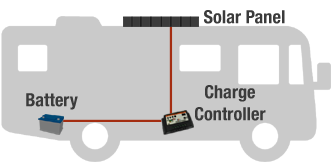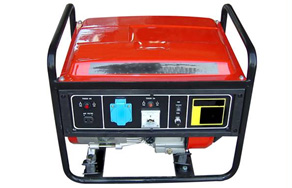RV Solar Battery Charger

A solar panel converts sunlight to electrical energy, which in turn is used to charge batteries.
Small solar panels of 15-20 watts are used to maintain RV batteries while not in use, while larger panels of 100-150 watts can often supply enough power to replace a full day’s use of the batteries.
Since 14+ volts are needed to do any charging, a 15 watt panel delivers about 1 amp to the battery(s).
That’s about enough to replace the 0.25 amps per hour that many RVs have as a background (phantom) load on the battery, even when everything appears to be turned off. Small solar panels are wired direct to a battery with no charge controller.
Just “adding a solar panel” is rarely satisfactory for a RV solar battery charger. It takes careful planning, the correct components, and often a professional installation to get desired results. Read more about RV Solar technology if you are considering this option.
Wind Charging
Another alternative charging method is the Wind Charger. Basically a propeller driving an alternator, the wind charger can provide a small supplemental charging current.
Because the propeller is fairly large and must be continually aimed to face into the wind, wind chargers are not common on RVs, but in deserts or in mountain valleys where there are constant winds, they can be a useful RV battery charger supplement.
Generators

Some campers bring a portable generator with them as well. People often say their generator is charging the batteries, but that isn’t really accurate.
In most cases, the generator is providing 120v power to the RV, the equivalent of shore power, and the RV’s own Converter or Inverter Charger is doing the charging chore.
Some portable generators have an output terminal that provides DC current that can be used for direct battery charging.
Many of these units wont provide enough voltage to charge the batteries fully as mentioned above. Additionally, even it if can fully charge the batteries, the generator may have unregulated voltage concerns.
This makes it risky to use if the battery gets near full charge and nobody turns the generator off.
[asa]B00068XCQU[/asa]
RV Battery Charger – Maintainers (Trickle Chargers)
A RV Battery Charger – Maintainer is simply a small charger intended to keep a fully charged battery at the 100% level.
These used to be small single stage units called trickle chargers, but the battery maintainer of today is a bit more sophisticated and does a Float Charge (see Multi-stage chargers).
Battery maintainers are usually designed to maintain a single 12v battery, but some models have multiple outputs so they can handle 2 or more at the same time.
A popular brand of battery maintainer for RVs is called the Battery Minder and another is the Battery Tender.
“Echo” Chargers and Battery Combiners
Technically these units are a switch rather than RV battery charger, but they serve the purpose by borrowing the charge from one battery and applying it to another.
They are very useful when the RV has two separate banks of batteries that are normally kept separate (isolated) but still need to be charged from one source.
The main RV battery charger is connected to the “main” battery and the Combiner “echos” a portion of the charging amps to the secondary battery while still keeping them isolated from each other.
In a motorhome this method is often used to charge the chassis (engine) battery from the house batteries while the RV is connected to shore power.
Some examples of RV Battery Combiners are the Xantrex Echo Charger, the Magnum Smart Battery Combiner, and the Ultra Trik-L-Start.



